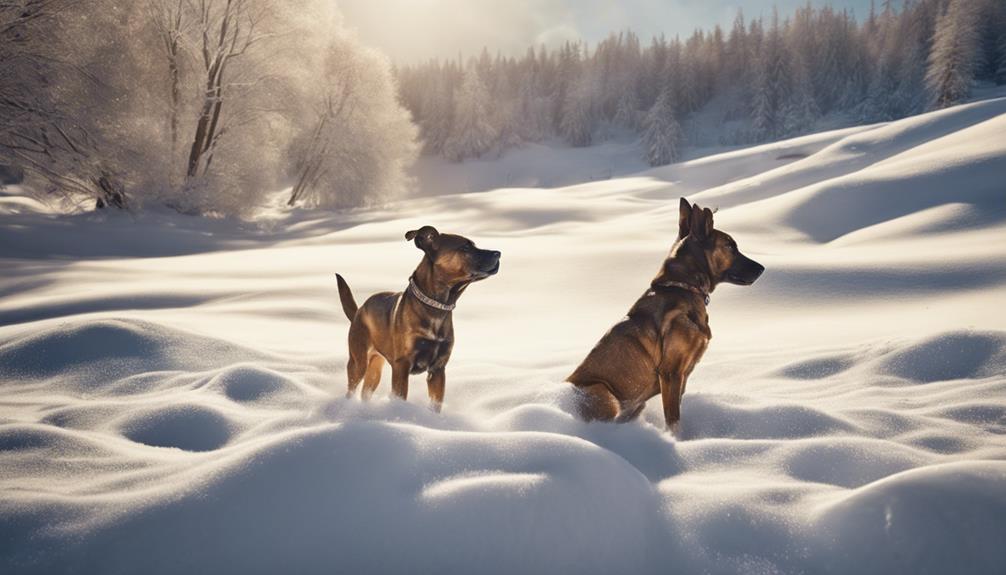When walking dogs in snowy areas, keep these tips in mind. Dress them in a waterproof coat for warmth. Insulated, well-fitted coats guarantee they move comfortably. Reflective gear boosts visibility. Protect paws with booties and moisturize their pads. Apply sunscreen on exposed areas for protection. Monitor hydration closely to prevent dehydration. Understand trail conditions like snow depth for safe walks. These basics secure your furry friend's safety and enjoyment in the snow. Additional insights await for enhancing your dog's snow adventures.
Key Takeaways
- Assess snow depth and ice patches for safe navigation.
- Use proper gear like boots for paw protection.
- Watch out for slippery ice patches to prevent accidents.
- Understand how different snow types affect movement.
- Ensure visibility with reflective gear for safety.
Dressing Your Dog for Snow
When gearing up your furry companion for snowy adventures, a waterproof and insulated coat is essential to shield them from the cold and snow. Dogs, just like us, can feel the chill of winter, so ensuring they've proper attire is vital for their comfort and well-being. A well-fitted coat not only keeps them warm but also allows for easy movement when frolicking in the snow. Opting for a reflective or brightly colored jacket adds an extra layer of safety by increasing visibility in snowy conditions, especially during those shorter winter days.
In addition to a coat, don't forget about your dog's paws. Snow and ice can be harsh on their sensitive pads, so using dog booties is a great way to protect their feet. These booties not only prevent snow from accumulating between their paw pads but also provide traction on slippery surfaces, ensuring a fun and safe snowy adventure for your furry friend. Remember to regularly inspect their paws for any signs of irritation or frostbite, keeping them happy and healthy throughout the winter season.
Protecting Paws From Cold

To safeguard your dog's paws from the cold, consider using paw booties for insulation, moisturizing their paw pads regularly, and checking for ice balls between their toes.
These simple measures can help guarantee comfort and potential injuries caused by exposure to the icy terrain.
Paw Booties for Insulation
We highly recommend considering paw booties as essential gear to protect your dog's paws from the cold, ice, and snow. These booties provide insulation, preventing frostbite and injuries from sharp objects during winter hikes. Designed with durable materials and non-slip soles, they offer traction on slippery surfaces, ensuring your dog's safety.
Properly fitted booties stay securely on your dog's paws, providing continuous protection during outdoor activities. Available in various sizes to fit different breeds, paw booties are a valuable investment for winter hiking. When gearing up for snowy terrain adventures with your dog, adding paw booties to your winter hiking gear can enhance their comfort and safety, allowing for an enjoyable and worry-free experience.
Moisturize Paw Pads
Moisturizing paw pads with paw wax or balms is a crucial step in safeguarding dogs' paws from the cold, dry, and abrasive snowy terrain. Regular application of these moisturizers helps establish a protective barrier, preventing issues like ice buildup, cracking, and irritation during winter hikes. Dry, cracked paw pads can result in discomfort and potential injuries for our furry friends. By keeping paw pads supple, hydrated, and resilient, we guarantee their paw health and comfort in harsh winter conditions. Here's a helpful table to guide you on the advantages of moisturizing your dog's paw pads:
| Advantages of Moisturizing Paw Pads |
|---|
| Prevents ice buildup |
| Avoids cracking |
| Reduces irritation |
| Maintains hydration |
| Ensures paw health |
Check for Ice Balls
Inspecting for ice balls between your dog's toes is important to safeguard their paws from the cold and prevent discomfort or injury during snowy hikes. Ice balls can form from snow accumulation, causing pain, limping, and even frostbite if not addressed promptly.
To prevent irritation, regularly check your dog's paws and remove any ice balls. Utilizing protective wax or booties can help avoid ice ball formation and maintain your dog's paw health in cold conditions.
Proper paw care is vital for ensuring your dog's comfort and safety while traversing snowy terrain. By being proactive and attentive to your furry companion's paws, you can prevent potential issues and make snowy adventures more enjoyable for both of you.
Applying Sunscreen on Dog

How can applying sunscreen benefit dogs when venturing out in the sun?
Sunscreen plays an important role in protecting our furry friends from harmful UV rays that can cause sunburn and skin damage. Dogs with exposed skin areas, like their nose, ears, and belly, are particularly vulnerable to these issues.
Opt for a pet-safe sunscreen specifically designed for dogs to make sure it doesn't contain any harmful ingredients if licked or ingested. Remember to apply the sunscreen at least 30 minutes before sun exposure, covering all vulnerable areas, and don't forget to reapply as needed, especially after activities like swimming or excessive sweating.
Staying Hydrated in Snow

Proper hydration is essential for dogs in snowy terrain to avoid health risks. Signs of dehydration, like excessive panting and lethargy, can help you identify when your dog needs water.
Using a collapsible bowl and monitoring water intake are vital methods to keep your furry friend hydrated during snowy adventures.
Water Intake Importance
Staying hydrated in snow is essential for dogs to prevent dehydration and maintain their well-being and performance. Snowy terrain and the dry winter air can lead to increased energy expenditure, making it important for dogs to maintain proper hydration levels.
While dogs may try to eat snow, relying on it alone can lower their body temperature and hinder water intake. Providing access to liquid water is crucial in preventing dehydration in these conditions. It's important to monitor your dog's water intake and encourage regular drinking to make sure they stay hydrated.
Dehydration can have serious consequences, impacting your dog's health, performance, and overall well-being. Be attentive to their hydration needs, especially in snowy environments, to keep them healthy and active.
Signs of Dehydration
Ensuring your dog's hydration in snowy terrain is important, as dehydration can still occur despite the cold environment. Signs of dehydration in dogs, like dry gums, sunken eyes, lethargy, and excessive panting, should be monitored closely. Snowy terrain can lead to increased water loss through breathing and exertion, making proper hydration vital. To help you visualize the importance of recognizing signs of dehydration, here is a table showing common symptoms:
| Signs of Dehydration | Description | Action Needed |
|---|---|---|
| Dry Gums | Lack of moisture in gums | Offer water immediately |
| Sunken Eyes | Eyes appear hollow | Provide shade and water |
| Lethargy | Lack of energy or enthusiasm | Encourage rest and hydration |
Be vigilant and proactive in maintaining your dog's hydration levels during snowy adventures.
Hydration Methods
Carrying extra water for your dog is crucial when traversing snowy terrain, as snow isn't a dependable source of hydration. To guarantee your furry companion stays hydrated on snowy hikes, consider these tips:
- Invest in a collapsible water bowl for convenient water access.
- Hydrate your dog frequently during long winter hikes to prevent dehydration.
- Be prepared for frozen natural water sources on the trail.
Familiarizing With Trail Conditions

Before embarking on a snowy trail with your dog, assess the trail conditions for snow depth, ice patches, and any recent avalanches to guarantee safe navigation. Snow depth can vary greatly, impacting your dog's traction and overall movement. Different snow types, such as powder, packed, or icy snow, can influence how well your dog can walk on the trail.
Watch out for ice patches that could present slipping hazards. Look for signs of animal tracks or previous hikers to assess the trail difficulty and anticipate potential obstacles like hidden tree roots, rocks, or steep drop-offs concealed under the snow. Get familiar with snow trail markers or signs specific to the area to navigate safely in snowy terrain.
Using Reflective Gear

Traversing snowy terrain with your dog becomes safer and more efficient by equipping them with reflective gear, enhancing visibility in low light conditions. When it comes to guaranteeing your furry companion's safety and making them stand out in the winter landscape, reflective gear is a game-changer.
Here are three reasons why using reflective gear is essential:
- Enhanced Visibility: Reflective collars, leashes, vests, or booties bounce back light from different sources, making your dog easily visible in the snowy terrain.
- Safety First: Opting for high-quality reflective gear is vital for ensuring your dog's safety by making them easier to spot, especially in low light conditions.
- Durability Matters: Investing in durable reflective gear not only enhances visibility but also ensures that the gear lasts through various snowy adventures, providing long-term safety benefits.
Equip your furry friend with reflective gear to navigate the snowy terrain with confidence and freedom.
Keeping Your Dog Leashed

To guarantee safety and control in snowy terrain, keeping your dog leashed is vital. In challenging snowy terrains, leashing your dog guarantees their safety and comfort while preventing them from wandering into potentially hazardous areas.
By keeping your furry companion on a leash, you maintain control over their movements, reducing the risk of encounters with wildlife or other hikers. Additionally, in snowy conditions where visibility may be limited, having your dog leashed is essential to avoid accidents and to guide them effectively through designated trails.
This practice not only minimizes the chances of your dog getting stuck in deep snow or icy patches but also establishes a physical connection between you and your pet, allowing for better guidance and support. Remember, leashing your dog in snowy terrains not only keeps them safe but also enhances your overall adventure experience by ensuring both you and your canine companion can navigate the winter wonderland with ease.
Frequently Asked Questions
How Long Can a Dog Hike in Snow?
When hiking in snow, how long a dog can go varies based on breed, age, fitness, and weather. Short-haired breeds may struggle more in the cold. Typically, a healthy dog can handle 1-3 hours in snowy terrain.
Keep an eye out for signs of fatigue or discomfort. Older dogs or those with health issues may tire faster. Start with short hikes and gradually increase based on your dog's response and conditioning.
How Long Should Dogs Play in the Snow?
When enjoying snowy playtime, it's important to take into account factors like breed, size, and coat thickness to determine how long dogs should play in the snow. Monitoring for discomfort signs such as shivering, paw lifting, or whining is vital.
Short-haired or small dogs may need shorter play sessions to prevent cold-related issues. Always keep a close eye on your furry friend and adjust playtime accordingly to guarantee a safe and enjoyable experience in the snow.
What Do Dogs Need for Winter Hiking?
We need to make sure our furry companions are ready for winter hikes. They require warm jackets, especially short-haired breeds, to stay cozy.
Paw protection like booties or wax is vital to prevent snow and ice buildup.
Carrying a first aid kit is essential for addressing any injuries or emergencies.
Hydration is key, so bring extra water and a collapsible bowl for your dog.
Leashing them is important for safety in unfamiliar and potentially hazardous winter terrain.
How Do You Walk a Dog in Below Freezing Temperatures?
When walking a dog in below freezing temperatures, it's important to protect them from the cold. Dress your furry friend in a warm coat and booties.
Keep walks short and watch for signs of discomfort like shivering or lifted paws. Schedule walks during warmer times of the day to minimize exposure.
Conclusion
To sum up, getting your furry companion ready for snowy escapades is essential for their safety and comfort. By heeding these suggestions, you can guarantee your dog stays warm, protected, and hydrated while exploring the winter wonderland. Remember, a well-prepared pooch is a happy pooch!
So gear up, leash up, and enjoy the snowy terrain with your four-legged friend by your side. Stay safe and have a paw-some time adventuring in the great outdoors!










